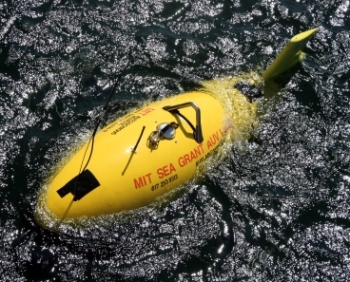MIT Researchers Develop a Small AUV Equipped with Artificial Intelligence
The search for oil and natural gas has intensified with the increasing demand and hence oil companies have been forced to set up oil wells at depths of 4000 meters below the sea level.
 MIT designed AUV
MIT designed AUV
Most of the oil companies make use of remotely operated vehicles (ROVs) robots for conducting inspection of these oil wells and pipes. Operating an ROV is a cumbersome process which involves huge costs. MIT researchers have been working on developing a remotely operated vehicle which is small and easily deployable. The research work is being conducted under the MIT Sea Grant Program lead by the director of the program ChryssostomosChryssostomidis.
The concept of an underwater vehicle which can operate automatically and travel into great depths of the ocean without a tether was suggested by Chryssostomidis during the 1980s. His research has radically transformed the concept of AUVs. He had proposed a design of the AUV in which it was completely functional and very small at the same time without a tether. This small design will enhance its manoeuvrability into tight spots, which will not be possible if it is designed with a tether. The AUV will be driven by artificial intelligence so that it is capable of choosing its direction in such a way that it avoids obstacles and also responds to the surroundings. Chryssostomidis had founded the AUV laboratory encompassed in the MIT Sea Grant College program and developed a number of AUVs of different sizes, having varied features and aided by artificial intelligence. The Odyssey AUVs that were designed from the institute were shaped like torpedoes having a streamlined horizontal design for fast cruising underwater. These vehicles were very effective in conducting survey missions.
The next step was to make the AUVs competent in performing intervention missions like inspections, repairs and service. The team therefore designed Odyssey IV, which was a hybrid cruising cum hovering vehicle. It is shaped like a tear drop equipped with four commercial off-the-shelf thrusters. The battery is made up of 648 lithium-ion cells which give it a long life and the required power to cruise deep into the ocean against strong currents. The Odyssey IV is capable of moving at the rate of 1.4 meters and reaches a depth of 6,000 meters below sea level. The AUV transmits images to the operator with a delay of just a few seconds and can travel for more than a day without the need for refuelling.
Please use one of the following formats to cite this article in your essay, paper or report:
APA
Choi, Andy. (2019, February 20). MIT Researchers Develop a Small AUV Equipped with Artificial Intelligence. AZoRobotics. Retrieved on December 31, 2025 from https://www.azorobotics.com/News.aspx?newsID=2214.
MLA
Choi, Andy. "MIT Researchers Develop a Small AUV Equipped with Artificial Intelligence". AZoRobotics. 31 December 2025. <https://www.azorobotics.com/News.aspx?newsID=2214>.
Chicago
Choi, Andy. "MIT Researchers Develop a Small AUV Equipped with Artificial Intelligence". AZoRobotics. https://www.azorobotics.com/News.aspx?newsID=2214. (accessed December 31, 2025).
Harvard
Choi, Andy. 2019. MIT Researchers Develop a Small AUV Equipped with Artificial Intelligence. AZoRobotics, viewed 31 December 2025, https://www.azorobotics.com/News.aspx?newsID=2214.
We're committed to providing free access to quality science. By registering and providing insight into
your preferences you're joining a community of over 1m science interested individuals and help us to
provide you with insightful content whilst keeping our service free.
or
Terms
While we only use edited and approved content for Azthena
answers, it may on occasions provide incorrect responses.
Please confirm any data provided with the related suppliers or
authors. We do not provide medical advice, if you search for
medical information you must always consult a medical
professional before acting on any information provided.
Your questions, but not your email details will be shared with
OpenAI and retained for 30 days in accordance with their
privacy principles.
Please do not ask questions that use sensitive or confidential
information.
Read the full Terms & Conditions.